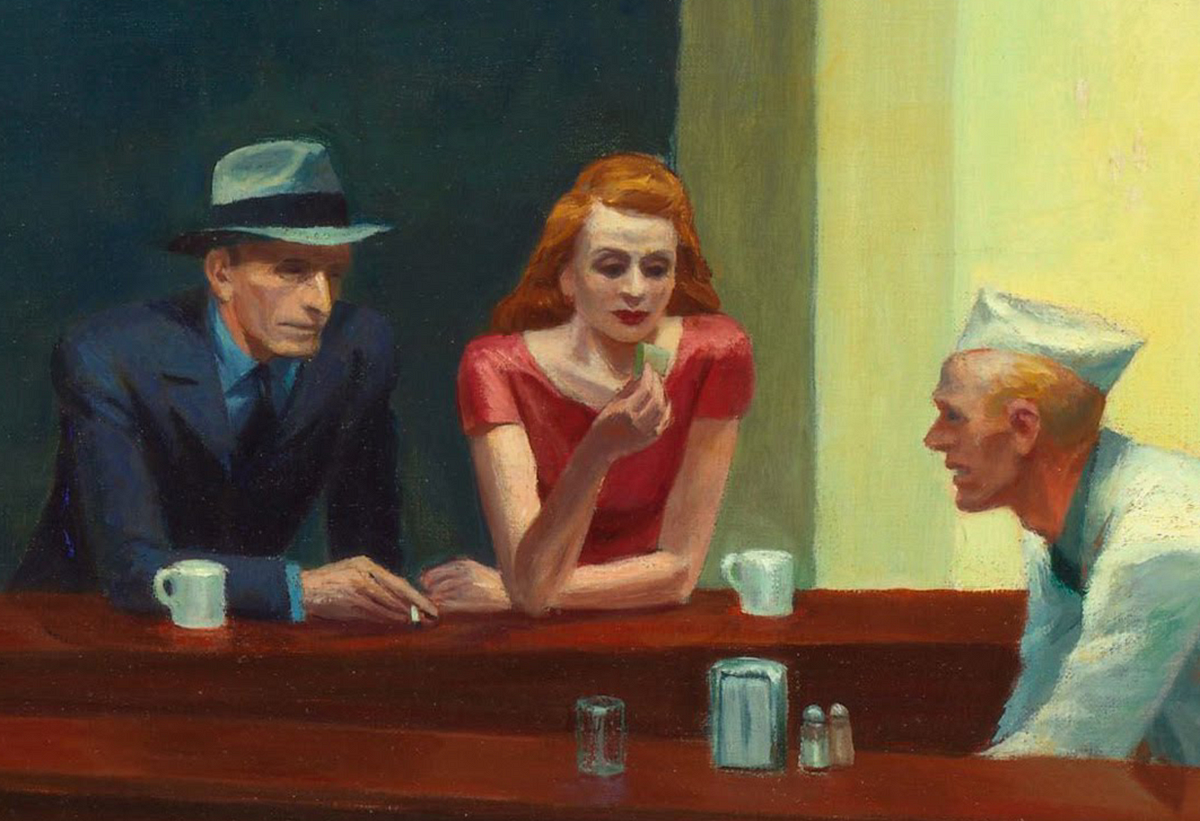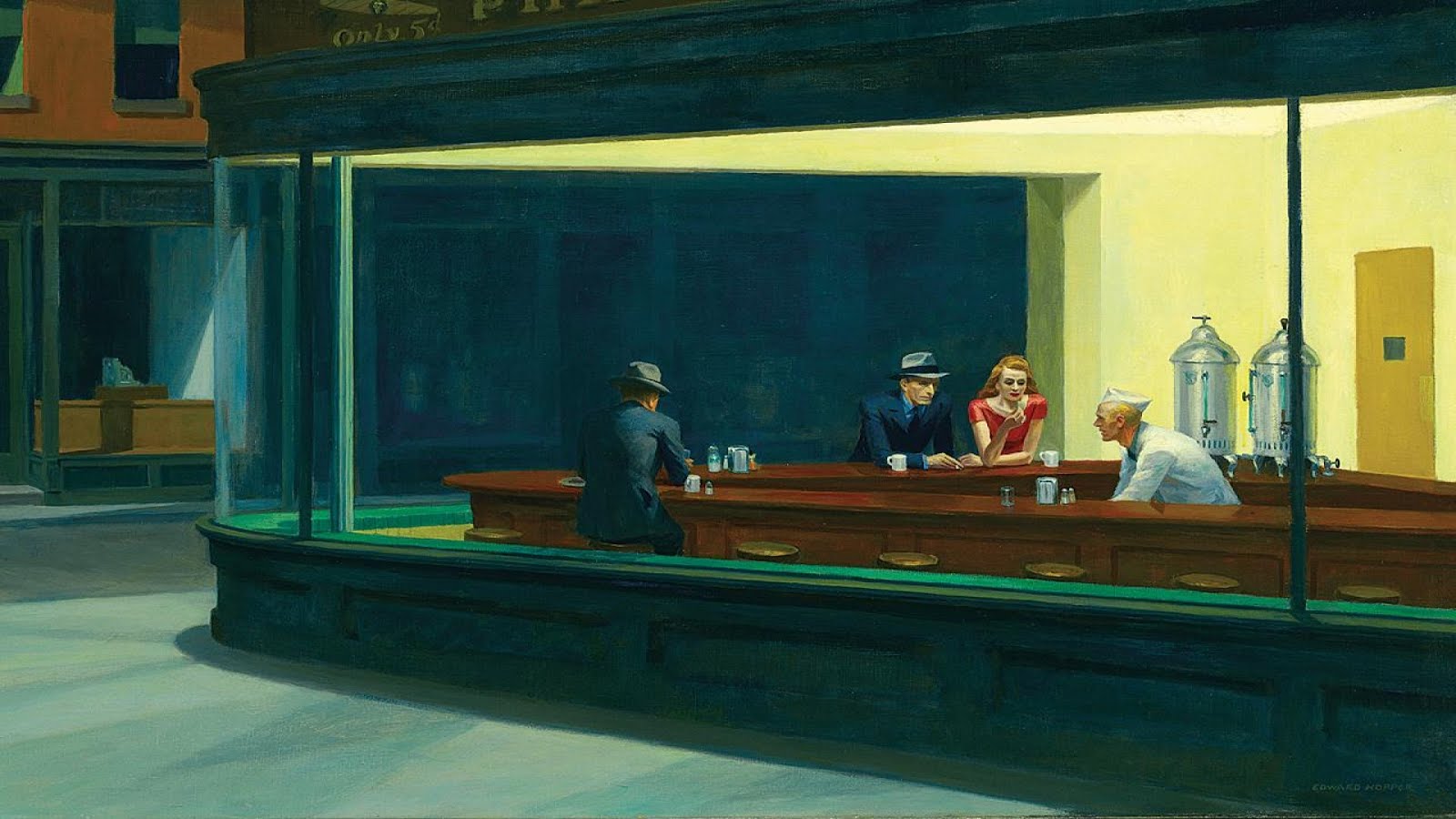Edward Hopper Nighthawks. It has been described as Hopper's best-known work and is one of the most recognizable paintings in American art. In many respects, Hopper was a painter of light.

The light coming from the diner illuminates a darkened and deserted urban streetscape. So many of his works utilise natural sunlight, often shown streaming in through a window or doorway, lighting up faces and casting shadows across. Renowned for his atmospheric oil paintings of lone or coupled figures, rural scapes and urban architecture, Edward Hopper's creative process has been considered anew with a touring exhibition entitled Hopper Drawing: A Painter's Process, organized by the Whitney Museum of.
It has been described as Hopper's best-known work and is one of the most recognizable paintings in American art. Nighthawks is one of Hopper's New York City paintings, and the artist said that it was based on a real café. Edward Hopper did not forget the door in his painting Nighthawks.
The man and woman might be touching hands, but they aren't. NARRATOR: In Nighthawks—probably Edward Hopper's most famous painting—four figures come together in a late-night diner, yet seem utterly apart. In many respects, Hopper was a painter of light.
The man and woman might be touching hands, but they aren't.
Edward Hopper's Creative Process: The Nighthawks and the Idyll.
Edward Hopper said that Nighthawks was inspired by "a restaurant on New York's Greenwich Avenue where two streets meet," but the image—with its carefully constructed composition and lack of narrative—has a timeless, universal quality that transcends its particular locale. In an all-night diner, three customers sit at the counter opposite a server, each appear to be lost in thought and disengaged from one another. It has been described as Hopper's best known work and one of the most recognizable paintings in American art.
The Nighthawks of the Hopper House from Beard & Bowler on Vimeo. The light coming from the diner illuminates a darkened and deserted urban streetscape. The man working behind the bar is physically separated from the customers by the long wooden bar, but he is also evidently the only one at work.
Inspired by a diner in Greenwich Village, Edward Hopper's Nighthawks, oil on canvas painting, is Hopper's most famous and recognizable work in American art. During a long career as an artist, Hopper had known both depression and success, and "Nighthawks. Solitary, hunched figures perch on stools along the slender countertop of an all-night diner.
In many respects, Hopper was a painter of light. It has been described as Hopper's best-known work and is one of the most recognizable paintings in American art. Das Bild gilt als Hoppers bekanntestes Werk und wird als eines der herausragendsten Werke US-amerikanischer Malerei angesehen.
Inspired by a diner in Greenwich Village, Edward Hopper's Nighthawks, oil on canvas painting, is Hopper's most famous and recognizable work in American art. NARRATOR: In Nighthawks—probably Edward Hopper's most famous painting—four figures come together in a late-night diner, yet seem utterly apart. The Nighthawks of the Hopper House from Beard & Bowler on Vimeo.
It has been described as Hopper's best known work and one of the most recognizable paintings in American art.
Seven of his paintings are referenced in the lyrics.
In an all-night diner, three customers sit at the counter opposite a server, each appear to be lost in thought and disengaged from one another. Many people have tried to find the exact setting of the painting, but have failed. The light coming from the diner illuminates a darkened and deserted urban streetscape.
Both Edward and Josephine Hopper were models for Nighthawks. Inspired by a diner in Greenwich Village, Edward Hopper's Nighthawks, oil on canvas painting, is Hopper's most famous and recognizable work in American art. It has been described as Hopper's best-known work and is one of the most recognizable paintings in American art.
Why is there no door in Nighthawks? Bright overhead lighting casts a theatrical play of shadows on the deserted sidewalk outside, with the sleek, curving form of the diner's. During a long career as an artist, Hopper had known both depression and success, and "Nighthawks.
The server lifts his head attentively, but doesn't seem to interact with anyone in particular. About Nighthawks Edward Hopper recollected, "unconsciously, probably, I was painting the loneliness of a large city.". Chicago, United States Edward Hopper said that "Nighthawks" was inspired by "a restaurant on New York's Greenwich Avenue where two streets meet," but the image—with its carefully constructed.
The Nighthawks Teen Leadership Program engages and mentors teens by teaching them leadership skills to deliver exhibitions, tours and programs to the public at the Edward Hopper House. It has been described as Hopper's best-known work and is one of the most recognizable paintings in American art. Nighthawks is one of Hopper's New York City paintings, and the artist said that it was based on a real café.
The light coming from the diner illuminates a darkened and deserted urban streetscape.
The Nighthawks of the Hopper House from Beard & Bowler on Vimeo.
In many respects, Hopper was a painter of light. Nighthawks is one of Hopper's New York City paintings, and the artist said that it was based on a real café. The server lifts his head attentively, but doesn't seem to interact with anyone in particular.
COURTESY WHITNEY MUSEUM OF AMERICAN ART, NEW YORK, PURCHASE AND GIFT OF JOSEPHINE N. Nighthawks is one of Hopper's New York City paintings, and the artist said that it was based on a real café. Edward Hopper said that Nighthawks was inspired by "a restaurant on New York's Greenwich Avenue where two streets meet," but the image—with its carefully constructed composition and lack of narrative—has a timeless, universal quality that transcends its particular locale.
Bright overhead lighting casts a theatrical play of shadows on the deserted sidewalk outside, with the sleek, curving form of the diner's. Inspired by a diner in Greenwich Village, Edward Hopper's Nighthawks, oil on canvas painting, is Hopper's most famous and recognizable work in American art. Edward Hopper did not forget the door in his painting Nighthawks.
About Nighthawks Edward Hopper recollected, "unconsciously, probably, I was painting the loneliness of a large city.".
Bright overhead lighting casts a theatrical play of shadows on the deserted sidewalk outside, with the sleek, curving form of the diner's.
The time when the artist worked was set in the modernist era marked by the emergence and development of such. The man working behind the bar is physically separated from the customers by the long wooden bar, but he is also evidently the only one at work. Edward Hopper did not forget the door in his painting Nighthawks.
In an all-night diner, three customers sit at the counter opposite a server, each appear to be lost in thought and disengaged from one another. In his wife's diaries, she wrote that she and Hopper himself both served as models for the people in the painting. During a long career as an artist, Hopper had known both depression and success, and "Nighthawks.
Das Bild gilt als Hoppers bekanntestes Werk und wird als eines der herausragendsten Werke US-amerikanischer Malerei angesehen. Often described as a "timeless" painting, it depicts an every day - or every night - scene of four people in a diner. The lack of a door is thought to symbolize man's solitude in the world.
The man working behind the bar is physically separated from the customers by the long wooden bar, but he is also evidently the only one at work. Solitary, hunched figures perch on stools along the slender countertop of an all-night diner. Each one in turn seems to be dealing with their own feelings of loneliness and isolation.

















